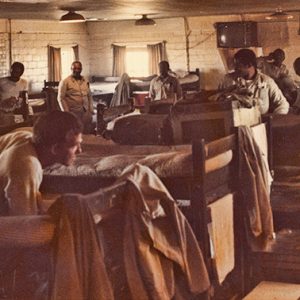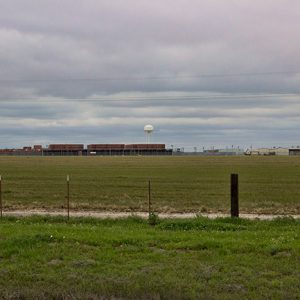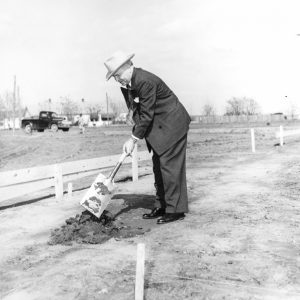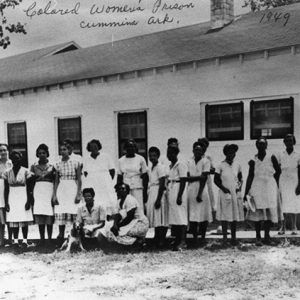calsfoundation@cals.org
Cummins Unit
aka: Cummins Prison Farm
Cummins Unit is a 16,600-acre maximum-security prison located five miles southeast of Grady (Lincoln County). Cummins is run by the Arkansas Department of Correction and houses male and female inmates. It is also the location of Arkansas’s facilities for administering the death penalty. Cummins is the oldest and largest of the state’s working “prison farms,” which use inmate labor to grow crops and produce livestock.
In 1897, the Arkansas General Assembly established that the state could purchase “any lands, buildings, machinery, livestock and tools necessary for the use, preservation, and operation of the penitentiary.” In 1902, the state bought 10,000 acres of property—consisting of land from the Cummins and Maple Grove plantations—to create the Cummins prison farm. Cummins would later gain national notoriety, becoming a symbol of an unjust Arkansas penal system. But when they established the prison farm, officials hoped Cummins would be an improvement on the brutal and long-standing convict lease system.
Arkansas abolished the convict lease system in the 1910s, but the corruption and brutality of the penal system continued on the prison farms. Officials expected Cummins not only to keep inmates at work—picking cotton and tending other crops—but to make money, ensuring that the prison paid for itself. In many ways, Cummins provided continuity between the antebellum era and the Jim Crow South: African American inmates, like slaves before them, were exploited on plantation land for the sake of profit.
Arkansas intended Cummins to serve as the primary location for Black convicts. However, by the 1930s, Cummins housed all of Arkansas’s adult prisoners, though their living spaces were racially segregated. It was not until 1970 that Governor Winthrop Rockefeller’s administration, acting on a federal mandate, fully integrated Arkansas’s prisons. When Cummins was created, men (and later women) lived in barracks, which kept inmates not in individual cells but in military-style rows of bunks. Cummins was also unusual among American prisons in that its trusties—or inmate guards—carried weapons, though “free world” guards did not. Armed with shotguns, pistols, and high-powered rifles, trusties patrolled the prison, overseeing workers in the fields and maintaining order in the barracks. Trusties were at the top of the prisoner hierarchy, with “do-pops” (so called because they popped doors open for trusties) in the middle, and the “rank men” at the bottom. Cummins’s trusties were better fed and cared for than the men beneath them, using bribery to control the distribution of food and mail. They were the main source of keeping order and inflicting punishment, which included whippings, shootings, and the use of the infamous “Tucker Telephone.”
In 1940, thirty-six men escaped from Cummins, the largest prison break in Arkansas history, and although all were eventually recaptured or killed, those who survived cited the deplorable conditions in the prison for their actions. In 1944, lawyer Byron R. Brogard said that Arkansas prisons were “little improved over the Medieval system,” using “slave labor for the production of cotton rather than to rehabilitate the men.” He called Cummins a “10,000-acre state cotton plantation.” In the mid-twentieth century, Arkansas made occasional improvements to Cummins, including the installation of air-conditioners in 1949 and two new barracks in 1952. But Arkansans did not see the need for true reform. Defenders of the system believed, as one Arkansas Gazette article noted in May 1952, that prison farms kept inmates more subdued than northern prisons did.
Amid the fight for civil rights in the 1960s, however, state and national attention focused on the horrific conditions at Cummins. Elected in November 1966, Winthrop Rockefeller, the first Republican governor of Arkansas since Reconstruction, wanted to make Arkansas prisons far more humane. A state police report of prison conditions—begun under Governor Orval Faubus’s tenure but suppressed—shocked Rockefeller, who realized that the situation was worse than he imagined.
One of Rockefeller’s most controversial appointments was that of Tom Murton, a prison expert who had worked in Alaska and taught in Illinois before moving to Arkansas. Murton had success running Tucker prison farm in Jefferson County before Rockefeller transferred him to Cummins. In January 1968, Superintendent Murton unearthed—in the presence of the media—three skeletons buried in the levee on prison grounds. Murton believed that the remains were those of murdered convicts, and he thought there were as many as 200 other bodies buried at Cummins of people who had died under mysterious circumstances. The official report issued by the Rockefeller administration, which included forensic evidence, determined that the bodies showed no signs of violent death and that they were from a pauper’s grave. Murton, however, was highly critical of the official report, and some ex-Cummins inmates who were there in the 1960s and saw abuses first-hand have since sided with Murton’s assertion that there was a cover-up.
What is certain is that Murton became a political liability for Rockefeller. In March 1968, Rockefeller dismissed Murton after he had been Cummins’s superintendent for only a few months. Unfortunately for Rockefeller, he could not avoid bad publicity for Cummins. In 1970, federal judge J. Smith Henley declared the Arkansas prison system unconstitutional. By then, Rockefeller had begun serious reform at Cummins, including better food, sanitation, and medical treatment, as well the beginnings of educational programs. Most importantly, Rockefeller began the dismantling of the corrupt armed trusty system. Just before leaving office in 1971, Rockefeller commuted the sentences of all men on death row to life imprisonment.
Another champion of reform at Cummins was musician Johnny Cash, who played at the prison in April 1969. With his wife, June Carter Cash, as well as Carl Perkins and the Statler Brothers, Cash performed as part of his larger efforts to shed light on the need for rehabilitation in American prisons. Rockefeller also attended. According to Cummins’s inmate-run, uncensored paper the Pea Pickers Picayune, inmates “virtually flipped” during Cash’s show. After the concert, the Picayune dubbed him the “King of Cummins.” At the prison, Cash offered to pay $5,000 to help build a chapel, though his donation ultimately went to finish a chapel already underway at Tucker prison. It was not until 1977 that the Cummins chapel was finished.
Despite reform efforts by Rockefeller and others, in the 1970s, the horrors of Cummins became more widely known. In 1971, K. Wymand Keith, convicted in Arkansas of check fraud, published Long Line Rider about his years at Cummins. Though fictional, the novel vividly and accurately depicted prison abuses. That same year, nationally syndicated columnist Bob Greene wrote about a fifteen-year-old inmate scheduled for execution at Cummins, which had no age limit for convicts. In 1974, 200 inmates went on strike briefly . In 1977, photographer Bruce Jackson published Killing Time, a frank examination of prison life at Cummins. The book contained photographs and testimony from inmates and prison officials concerning how the prison had changed since the Rockefeller period and the reforms that were still needed. Another prison break occurred on January 1, 1979.
By the late 1970s, Cummins had rectified many of the worst abuses of the old system. New problems, however, had emerged. One was overcrowding. The national desire for “law and order” in the late 1960s and early 1970s led to an increasingly aggressive “drug war,” while some state legislatures became concerned more with retribution than rehabilitation. Such factors led to an explosion in the prison population in Arkansas. In June 1980, Cummins was short 200 beds. In 1982, however, Arkansas’s prisons finally became compliant with federal law: they were no longer deemed in violation of the Eighth Amendment’s prohibition against “cruel and unusual punishment.”
To add to Cummins’s legacy of troubles, in the 1990s, the public discovered that the prison had allegedly been selling tainted blood plasma, some of it infected with the HIV virus and hepatitis C. Nevertheless, in 1996, the American Correctional Association accredited Cummins for the first time. Since the Rockefeller administration, the prison had without question changed for the better. In 2002, Cummins commemorated its 100thanniversary, when officials noted the progress the prison had made. Former warden Willis Sargent noted that Cummins “went from the pits…to today [being] one of the finest institutions in the nation.” Were one to seek to work in corrections, Sargent said, “this is the prison to be at.”
However, conditions at Cummins continued to attract negative national attention, especially during the COVID-19 pandemic, which first hit Arkansas in early 2020. By April 10, 2020, thirteen employees of the Arkansas Department of Corrections had tested positive for the virus, and the first infected inmate was detected at the Cummins Unit. Further testing was done, showing that nearly 1,000 in the facility, including several staff, had been infected, leading the state to re-evaluate early release for those who had committed parole violations or other non-violent offenses. The outbreak at Cummins, located in rural Lincoln County, eventually became the densest COVID-19 hot spot in the nation, and conditions in the prison were reported in an array of national publications, including a harrowing June 22, 2020, New Yorker exposé.
For additional information:
Aviv, Rachel. “Punished by Pandemic.” New Yorker, June 22, 2020. Online at https://www.newyorker.com/magazine/2020/06/22/punishment-by-pandemic (accessed October 26, 2021).
Crosley, Clyde. Unfolding Misconceptions: The Arkansas State Penitentiary, 1836–1986. Arlington, TX: Liberal Arts Press, 1986.
House, Lamar. “A Dark and Evil World.” 2 parts. Arkansas Times (January 1987): 26–29, 80, 82–86, 88; (February 1987): 42–45, 65–70.
Jackson, Bruce. Killing Time: Life inside the Arkansas Penitentiary. Ithaca, NY: Cornell University Press, 1977.
———. Pictures from a Drawer: Prison and the Art of Portraiture. Philadelphia, PA: Temple University Press, 2009.
Murton, Tom, and Joe Hyams. Accomplices to the Crime. New York: Grove Press, 1969.
Woodward, Colin Edward. “At Cummins Prison: Johnny Cash and the Arkansas Penitentiary.” Pulaski County Historical Review 62 (Fall 2014): 85–92.
———.”‘There’s a Lot of Things That Need Changin'”: Johnny Cash, Winthrop Rockefeller, and Prison Reform in Arkansas.” Arkansas Historical Quarterly 79 (Spring 2020): 40–58.
Colin Woodward
Center for Arkansas History and Culture
 Brubaker
Brubaker Finney v. Hutto
Finney v. Hutto Lockhart, Art
Lockhart, Art Ruled by the Whip
Ruled by the Whip Varner Unit
Varner Unit Johnny Cash at Cummins
Johnny Cash at Cummins  Cummins Baptism
Cummins Baptism  Cummins Barracks
Cummins Barracks  Cummins Chapel
Cummins Chapel  Cummins Unit
Cummins Unit  Benjamin Laney
Benjamin Laney  Long Line Rider
Long Line Rider  Women Prisoners
Women Prisoners 



Comments
No comments on this entry yet.